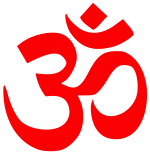Yajurveda
| Part of a series on |
| Hindu scriptures |
|---|
 |
| Vedas |
| Rigveda · Yajurveda Samaveda · Atharvaveda |
| Vedangas |
| Shiksha · Chandas Vyakarana · Nirukta Kalpa · Jyotisha |
| Upanishads |
| Rig vedic Aitareya Yajur vedic
Brihadaranyaka · Isha Taittiriya · Katha Shvetashvatara Sama vedic
Chandogya · Kena Atharva vedic
Mundaka · Mandukya Prashna |
| Puranas |
| Brahma puranas Brahma · Brahmānda Brahmavaivarta Markandeya · Bhavishya Shiva puranas
Shiva · Linga Skanda · Vayu |
| Epics |
| Ramayana Mahabharata (Bhagavad Gita) |
| Other scriptures |
| Manu Smriti Artha Shastra · Agama Tantra · Sūtra · Stotra Dharmashastra Divya Prabandha Tevaram Ramcharitmanas Yoga Vasistha |
| Scripture classification |
| Śruti · Smriti |
The Yajurveda (Sanskrit यजुर्वेदः yajurveda, a tatpurusha compound of yajus "sacrificial formula', + veda "knowledge") is the third of the four canonical texts of Hinduism, the Vedas. By some, it is estimated to have been composed between 1,400 and 1000 BCE, the Yajurveda 'Samhita', or 'compilation', contains the liturgy (mantras) needed to perform the sacrifices of the religion of the Vedic period, and the added Brahmana and Shrautasutra add information on the interpretation and on the details of their performance.
Contents |
Recensions
There are two primary versions or Samhitas of the Yajurveda: Shukla (white) and Krishna (black). Both contain the verses necessary for rituals, but the Krishna Yajurveda includes the Brahmana prose discussions within the Samhita, while the Shukla Yajurveda has separately a Brahmana text, the Shatapatha Brahmana.
Shukla Yajurveda
There are two (nearly identical) shakhas or recensions of the Shukla (White) Yajurveda, both known as Vajasaneyi-Samhita (VS):
- Vajasaneyi Madhyandiniya (VSM), originally of Mithila (Bihar)
- Vajasaneyi Kanva of originally of Kosala (VSK)
The former is popular in North India, Gujarat, parts of Maharashtra (north of Nashik) and thus commands a numerous following. The Kanva Shakha is popular in parts of Maharashtra (south of Nasik), Orissa, Karnataka, Andhra Pradesh and Tamil Nadu. Sureshvaracharya, one of the four main disciples of Jagadguru Adi Shankara, is said to have followed the Kanva shakha. The Guru himself followed the Taittiriya Shakha with the Apastamba Kalpasutra. The Vedic rituals of the Ranganathaswamy Temple at Srirangam, the second biggest temple in India, are performed according to the Kanva shakha. Raghu vamsam; Dasaratha and Sri Rama's clan follows the Shukla Yajurveda branch. The White Yajurveda has two Upanishads associated with it: the Ishavasya and the Brihadaranyaka Upanishads. The Brihadaranyaka Upanishad is the most voluminous of all Upanishads.
The VS has forty chapters or adhyayas (but 41 in Orissa), containing the formulas used with the following rituals:
- 1.-2.: New and Full Moon sacrifices
- 3.: Agnihotra
- 4.-8.: Somayajna
- 9.-10.: Vajapeya and Rajasuya, two modifications of the Soma sacrifice
- 11.-18.: construction of altars and hearths, especially the Agnicayana
- 19.-21.: Sautramani, a ritual originally counteracting the effects of excessive Soma-drinking
- 22.-25.: Ashvamedha
- 26.-29.: supplementary formulas for various rituals
- 30.-31.: Purushamedha
- 32.-34.: Sarvamedha
- 35.: Pitriyajna
- 36.-39.: Pravargya
- 40.: the final adhyaya is the famous Isha Upanishad
Krishna Yajurveda
There are four recensions of the Krishna Yajurveda:
- Taittirīya saṃhita (TS) originally of Panchala
- Maitrayani saṃhita (MS) originally of the area south of Kurukshetra
- Caraka-Katha saṃhita (KS) originally of Madra and Kurukshetra
- Kapiṣṭhala-Katha saṃhita (KapS) of the southern Panjab, Bahika
Each of the recensions has or had a Brahmana associated with it, and most of them also have associated Shrautasutras, Grhyasutras, Aranyakas, Upanishads and Pratishakhyas.
The Taittiriya Shakha: The best known and best preserved of these recensions is the TS, named after Tittiri, a pupil of Yaska. It consists of 7 books or kandas, subdivided in chapters or prapathakas, further subdivided into individual sections (anuvakas). Some individual hymns in this Samhita have gained particular importance in Hinduism; e.g. TS 4.5 and TS 4.7 constitute the Rudram Chamakam, while 1.8.6.i is the Shaivaite Tryambakam mantra. The beejas bhūr bhuvaḥ suvaḥ prefixed to the (rigvedic) Savitur Gayatri mantra are also from the Yajurveda. The Taittiriya recension of the Black Yajurveda is the shakha now most prevalent in southern India. Among the followers of this Shakha, the Apastamba Sutras are the common. The Taittiriya Shakha consists of Taittiriya Samhita (having seven kandas), Taittiriya Brahmana (having three kandas), Taittiriya Aranyaka (having seven prashnas) (See Aranyaka Literature), Taittiriya Upanishad (having three prashnas or vallis - Shiksha valli, Ananda valli and Bhrigu valli) and the Mahanarayana Upanishad. The Taittiriya Upanishad and Mahanarayana Upanishad are considered to be the seventh, eighth, ninth and tenth prashnas of the Aranyaka. The words prapathaka and kanda (meaning sections) are interchangeably used in Vedic literature. Prashna and valli refer to sections of the Aranyaka.
There is another Short tract apart from the above and that is commonly known as Ekagni Kanda which mainly consists of mantra-s used in the marriage and other rituals.
Literature
- Ralph Thomas Hotchkin Griffith, The Texts of the White Yajurveda. Translated with a Popular Commentary (1899).
- Devi Chand, The Yajurveda. Sanskrit text with English translation. Third thoroughly revised and enlarged edition (1980).
- The Sanhitâ of the Black Yajur Veda with the Commentary of Mâdhava ‘Achârya, Calcutta (Bibl. Indica, 10 volumes, 1854-1899)
- Kumar, Pushpendra, Taittiriya Brahmanam (Krsnam Yajurveda), 3 vols., Delhi (1998).
See also
- Yajna
- Kalpa (Vedanga)
- Shatapatha Brahmana
- Mahīdhara
- Vedas
External links
- Sanskrit Web Freely downloadable, carefully edited Sanskrit texts of Taittiriya-Samhita, Taittiriya-Brahmana, Taittiriya-Aranyaka, Ekagni-Kanda etc. as well as English translations of the Taittiriya-Samhita etc.
- Albrecht Weber, Die Taittirîya-Samhita 1871
- Ralph Griffith, The Texts of the White Yajurveda 1899, full text, (online at sacred-texts.com)
- A. Berridale Keith, The Yajur Veda - Taittiriya Sanhita 1914, full text, (online at sacred-texts.com)